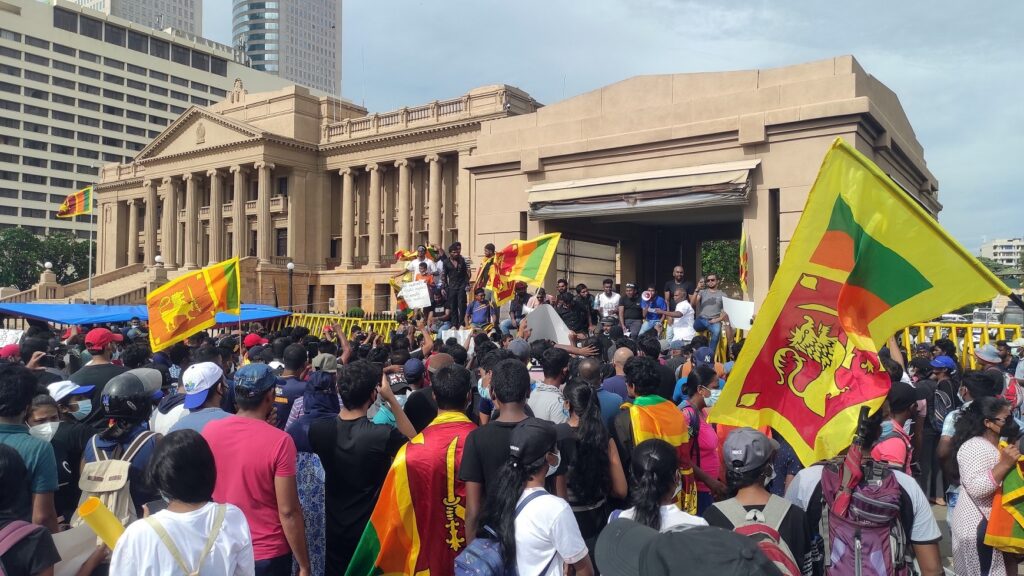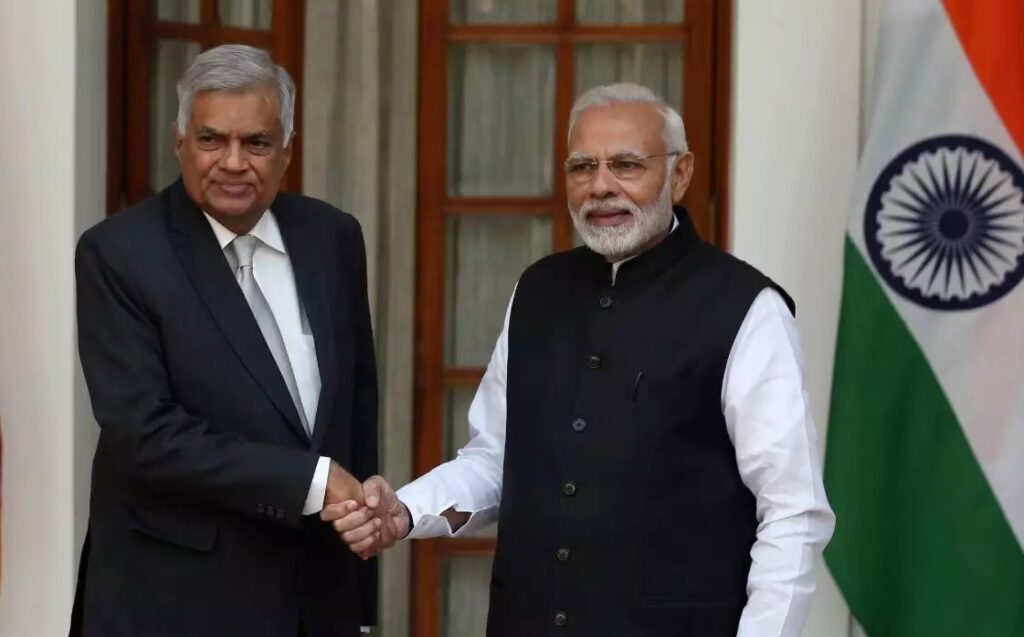
- Sri Lanka never focused on wealth creation, but only on the wealth distribution, by taking endless loans from international players and organisations.
- There are some pro LTTE Tamil elements who are hijacking protests which might lead to the return of extremism and the reign of terror.
- India must develop a bilateral security pact with Sri Lanka, in order to secure the Indian Ocean region from being utilised by China and the West, for its sinister plots to gain supremacy in the emerging new cold war.
- Declaring Sri Lanka one of India’s principle strategic defence partners becomes quite essential, to gain the needed strategic ground to establish stability in the country.
Sri Lanka Is facing one of the worst internal political crises in its history. From total economic fallout, to mass protests getting out of hand in the country, the situation has become quite fluid and volatile. As Mr Ranil Wickremesinghe has taken over as the president, the protests in Colombo show no signs of a let up. The famous protest slogan, “Ranil go and Gota Go” has been constantly clamoured throughout the protests which are getting quite violent, being hijacked by radical left wing outfits in the country. It’s truly a travesty that a country with excellent social indicators, booming tourism and a strategic transit for geo-economics is grappling with such an unprecedented crisis. Most people blame the country’s irredentist economic policies for this current situation, but the nauseating politics is equally responsible for this distressing situation.
Sri Lanka’s Political Saga – The Past and the Present
Sri Lanka became an independent country on 4th February 1948, as it obtained freedom from British colonial rule. The political leaders of the country made a collective pledge to establish democracy, rule of law and equality for all its citizens. There was also a strong commitment towards developing Sri Lanka into an idealist welfare state, to ensure that all its citizens would become the beneficiaries of social welfare and therefore achieve progress and prosperity. In fact this dream did come true to an extent. In the whole of South Asia, it had the best social indicators in infant mortality rate, maternal mortality rate and low malnutrition. Simultaneously their political leadership strongly pushed for sustainable agriculture and tourism, and in both these areas, Sri Lanka flourished quite impressively.
But Sri Lanka’s politics has always faced communal crisis with its Sinhala majoritarianism, Tamil separatism and now, even with the rise of Islamist radicalisation. In 1956 former Prime minister SWRD Bandaranaike passed the “Sinhala Only” bill, declaring that only Sinhala can be the national language of Sri Lanka. But this divisive move triggered protests from Sri Lanka’s Tamils, led by their prominent leader Chaluvanayakam. Though initially this protest movement failed, later it manifested into a violent uprising, leading to the infamous communal riots between the Tamils and Lankan Buddhists. Mr Bandaranaike’s government was forced to make some amends to its language law to accommodate the Tamils. However, it was only in 1988 that the Sri Lankan Tamils got an equal status not just for their language but also to their community, who in a way were considered to be a set of second class citizens. Despite changes in laws and political accommodation made over a period of time, Sri Lankan Tamils faced a lot of atrocities and discrimination which led to the rise LTTE (Liberation Tigers of Tamil Eelam).
The unfortunate radical push by its right wing leaders has made the country completely polarised, divisive and permanently ghettoised.
The rise and fall of LTTE is known to everyone, and I would not be focusing on it here. But the point I’m trying to make here is that the unfortunate radical push by its right wing leaders has made the country completely polarised, divisive and permanently ghettoised. In the guise of such high voltage polarisation, people seem to have been kept in complete darkness about the systemic corruption, and its policy failures in making the state as an exclusive social welfare basket, wherein this basket case which is fed on the steroids of socialism has experienced a complete systemic collapse. To put it in simple terms, Sri Lanka never focused on wealth creation, but only on the wealth distribution, by taking endless loans from international players and organisations. They pumped most of their budget into social welfare schemes, which became a major reason for their defaulting.
The Rajapaksa family’s misrule and blunders added fuel to the crisis in Sri Lanka which has led to the mass protest movements across the country. From burning down Mr Wickremesinghe’s house, to barging into the presidential palace, protesting mobs are taking the country towards anarchy. People’s frustration and anger is heading towards extreme ends. The SJP (Samagi Jana Balawegaya) leader Sajith Premadasa, who is the principal opposition leader of Sri Lanka is aligning himself with radical left wing outfits such as IUCF ( Inter University Students Federation) and FSP (Front-line socialist party) , and they are displaying worrying signs of anti establishment, anti corporate sentiments and are giving an all out call for the withering away of the state and its sovereignty. What becomes more alarming is the fact that they are well organized in their collective action and are outrightly displaying militaristic tendencies. We need to note that protests, politics and mobocracy are entirely different, protesters morphing into mobs and rioting and ruling the streets is becoming a major law and order challenge for Sri Lanka, it has no longer remained a peaceful protest oriented towards a specific cause. There are some pro LTTE Tamil elements who are hijacking protests which might lead to the return of extremism and the reign of terror. But so far no movement of arms or ammunition have been detected, which is certainly a sign of relief.
But adding fuel to this raging fire is the fact that, there are some confirmed reports about how these nationwide protests are being funded by some extremist evangelical Cristian organisations and some elements of the global Islamist networks like the Muslim brotherhood and ISIS linked moles within Sri Lanka. Because of this, some innocent peace loving Muslims have also been targeted by the radical Buddhists. We can easily say that Sri Lanka is seeing an all-round radicalisation in its communities which might lead to the further deterioration of the existing situation in the country.
Reports suggest that the nationwide protests are being funded by some extremist evangelical Cristian organisations and some elements of the global Islamist networks like the Muslim brotherhood and ISIS linked moles within Sri Lanka.
Managing the civilian protest has become a critical challenge for the Sri Lankan military and law enforcement agencies. Political establishment is not willing to enforce any military solution and, neither is the military sufficiently trained to handle such sensitive and delicate issues which requires far more than a brute force to bring the situation under control. Interestingly the Sri Lankan military is not willing to intervene in the current situation beyond the fundamental duties of crowd control and restoring law and order. They believe that harsh military action would further deteriorate the economic situation and will result in the country ending up in a severe geopolitical and diplomatic quandary.
It wouldn’t be wrong to say that Sri Lanka’s political class has “Created a monster, which it cannot contain”. The handling of social cohesion in the country has been a massive failure. It’s a travesty that the majoritarian politics of Sri Lanka, has steamrolled its diversity, rich and composite culture, and its coherent tapestry of social relations.
India’s Role and Policy Choices

India and Sri Lanka have had very strong historical bonds and a civilizational relationship. Over the past seven decades as both the countries have been freed from colonial occupation, India and Sri Lanka are steadily working towards developing their strategic ties both from a socio-political front and a geo-economic front. India has been actively involved in Sri Lanka’s welfare initiatives and developmental programs for several decades and India’s neighbourhood first policy has reignited the spirit of mutual partnership through aid and assistance through a proactive diplomacy and foreign policy. India has already provided an aid of 3.5 million to Sri Lanka, towards tackling its crisis and is planning to provide more assistance in terms of food grains and essential aid to the country. But apart from this, India has a huge responsibility to work with the government of Sri Lanka, to ensure the political stability during the current transition of power, as is it the first priority right now, in order to establish peace and re-install the rule of law in the country.
Further, it is important to understand that Sri Lanka’s military may need strategic support from India in terms of strengthening the defence co-operation, training and military exercises. Declaring Sri Lanka one of India’s principle strategic defence partners becomes quite essential, to gain the needed strategic ground to establish stability in the country. Sri Lanka has never had a history of such massive public or civic uprisings, though they have witnessed some sporadic youth uprising and, no doubt they successfully battled out the LTTE terrorism, but they are not efficiency trained in curbing civil uprisings of a massive scale.
As in the past and so in the future, India must remain a bulwark of strong mutual strategic partnership in aiding and assisting Sri Lanka to retain its democratic institutions in a situation of anarchy, and must continue to develop its security partnership at a marshalling pace. The newly elected President, Mr Ranil Wickremesinghe has an inclusive vision towards the security concerns of Indo-pacific, and has developed an Indian Ocean strategy wherein Sri Lanka’s national Interest and national security would be given first priority. All the future trade agreements and economic decisions would be made, keeping in mind the hegemonic characteristics of the global powers. But India would be an exception in the sense that the scrutiny which would be applied to China and the western powers will be exempted in India’s case. This strategy is very much favourable for India’s national interests as we share the same concerns with Sri Lanka. India must develop a bilateral security pact with Sri Lanka, in order to secure the Indian Ocean region from being utilised by China and the West, for its sinister plots to gain supremacy in the emerging new cold war.
Having political stability and proper institutional frameworks is the first condition that the IMF has laid out, in order to roll out its bailout package to Sri Lanka. As the country is struggling to get back to normalcy, due to the constant rise and fall of its civil uprisings, the task of saving the democratic character of the country along with safeguarding civil liberties and rule of law becomes the prime responsibility of its well meaning citizens. Though India has its strategic commitments towards Sri Lanka and intends to further develop the ties with its foreign policy initiatives, the mantle to restore Sri Lanka back to normalcy is exclusively a part of their internal affairs. Before sliding down towards further chaos and anarchy, it’s high time for Sri Lanka to “set its house in order”.
(The author has a MA in International Relations. Views expressed are author’s own)
Viswapramod is a PhD Scholar at the Department of International Studies and Political Science, Christ University, Bangalore. He has an MA in International Relations. Views expressed are the author’s own.
